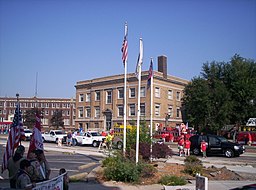Granite City, Illinois
| City of Granite City | |
| City | |
|
City Hall of Granite City
|
|
| Country | United States |
|---|---|
| State | Illinois |
| County | Madison |
| Elevation | 420 ft (128.0 m) |
| Coordinates | 38°43′04″N 90°07′46″W / 38.71778°N 90.12944°WCoordinates: 38°43′04″N 90°07′46″W / 38.71778°N 90.12944°W |
| Area | 20.70 sq mi (53.6 km2) |
| - land | 19.29 sq mi (50 km2) |
| - water | 1.41 sq mi (4 km2), 6.81% |
| Population | 29,849 (2010) |
| Density | 1,547/sq mi (597.3/km2) |
| Founded | 1896 |
| Mayor | Ed Hagnauer |
| Timezone | CST (UTC-6) |
| - summer (DST) | CDT (UTC-5) |
| Postal code | 62040 |
| Area code | 618 |
|
U.S. Census map
|
|
|
Website: www |
|
Granite City is a city in Madison County, Illinois, United States, within the Greater St. Louis metropolitan area. The population was 29,849 at the 2010 census, making it the second largest city in the Metro East and Southern Illinois regions, behind Belleville. Officially founded in 1896, Granite City was named by the Niedringhaus brothers, William and Frederick, who established it as a steel making company town for the manufacture of kitchen utensils made to resemble granite.
The area was settled much earlier than Granite City's official founding. In the early 19th century, settlers began to farm the rich fertile grounds to the east of St. Louis. Around 1801, the area saw the establishment of Six Mile Settlement, a farming area that occupied the area of present-day Granite City, six miles (10 km) from St. Louis. Soon after, around 1806, the National Road was to be constructed through the area, but it was never completed. By 1817, the area became known as Six Mile Prairie, to distinguish it from Six Mile Township. By 1854, the first railroad was built. In 1856, the area known as Six Mile would be changed to Kinder.
Granite City was founded in 1896 to be a planned company city similar to Pullman, Illinois, by German immigrant brothers Frederick G. and William Niedringhaus for their Granite ware kitchen supplies factory.
Since 1866, the brothers had been operating the St. Louis Stamping Company, an iron works company, that made kitchen utensils in St. Louis, Missouri. In the 1870s, William discovered an enamelware process in Europe whereby metal utensils could be coated with enamel to make them lighter and more resistant to oxidation. At the time, most enamelware was usually just one color as the additions of any colors to the process was inefficient. On June 1, 1878, William applied for Patent 207543 to improve the efficiency whereby a pattern could be applied to enamelware while the enamel was still wet simply by placing a thin piece of paper with an oxidized pattern on top of it. The paper would fall off in the drying process and the pattern was embedded. The brothers' pattern made the utensils resemble granite. The resulting product was enormously popular.
...
Wikipedia



